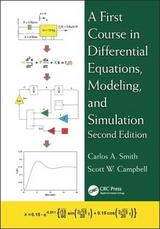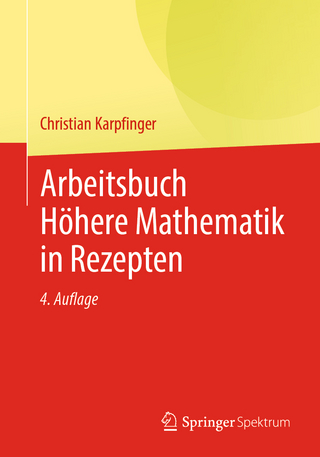
A First Course in Differential Equations, Modeling, and Simulation
Crc Press Inc (Verlag)
978-1-4398-5087-9 (ISBN)
- Titel erscheint in neuer Auflage
- Artikel merken
Using simple physics, the book introduces dynamic modeling, the definition of differential equations, two simple methods for obtaining their analytical solution, and a method to follow when modeling. It then presents classical methods for solving differential equations, discusses the engineering importance of the roots of a characteristic equation, and describes the response of first- and second-order differential equations. A study of the Laplace transform method follows with explanations of the transfer function and the power of Laplace transform for obtaining the analytical solution of coupled differential equations.
The next several chapters present the modeling of translational and rotational mechanical systems, fluid systems, thermal systems, and electrical systems. The final chapter explores many simulation examples using a typical software package for the solution of the models developed in previous chapters.
Providing the necessary tools to apply differential equations in engineering and science, this text helps readers understand differential equations, their meaning, and their analytical and computer solutions. It illustrates how and where differential equations develop, how they describe engineering systems, how to obtain the analytical solution, and how to use software to simulate the systems.
Carlos A. Smith is a professor emeritus in the Department of Chemical and Biomedical Engineering at the University of South Florida. He has co-authored three editions of Principles and Practice of Automatic Process Control and authored Continuous Automated Process Control. Scott W. Campbell is a professor in the Department of Chemical and Biomedical Engineering at the University of South Florida, where he has recently incorporated applications and projects into the calculus sequences for engineering and life sciences students. His research interests encompass the areas of thermodynamics and environmental monitoring and modeling.
Introduction
An Introductory Example
Modeling
Differential Equations
Forcing Functions
Book Objectives
Objects in a Gravitational Field
An Example
Antidifferentiation: Technique for Solving First-Order Ordinary Differential Equations
Back to Section 2-1
Another Example
Separation of Variables: Technique for Solving First-Order Ordinary Differential Equations
Back to Section 2-5
Equations, Unknowns, and Degrees of Freedom
Classical Solutions of Ordinary Linear Differential Equations
Examples of Differential Equations
Definition of a Linear Differential Equation
Integrating Factor Method
Characteristic Equation
Undetermined Coefficients
Response of First- and Second-Order Systems
Application of the Mathematics to Design
Laplace Transforms
Definition of the Laplace Transform
Properties and Theorems of the Laplace Transform
Solution of Differential Equations Using Laplace Transform
Transfer Functions
Algebraic Manipulations Using Laplace Transforms
Deviation Variables
First- and Second-Order Systems
Mechanical Systems: Translational
Mechanical Law and Experimental Facts
Types of Systems
D’Alembert’s Principle and Free Body Diagrams
Additional Examples
Vertical Systems
Mechanical Systems: Rotational
Mechanical Law, Moment of Inertia, and Torque
Torsion Springs
Rotational Dampening
Gears
Systems with Rotational and Translational Elements
Mass Balances
Conservation of Mass
Flow Rates and Concentrations
Flow Element and Experimental Facts
Examples of Mass Balances
Thermal Systems
Conservation of Energy
Modes of Heat Transfer
Conduction
Convection
Conduction and Convection in Series
Accumulated or Stored Energy
Some Examples
Heat Transfer in a Flow System
Electrical Systems
Some Definitions and Conventions
Electrical Laws and Electrical Components
Examples of Electrical Circuits
Additional Examples
RC Circuits as Filters
Numerical Simulation
Numerical Solution of Differential Equations
Euler’s Method for First Order Ordinary Differential Equations
Euler’s Method for Second Order Ordinary Differential Equations
Step Size
More Sophisticated Methods
Representation of Differential Equations by Block Diagrams
Additional Examples
Index
A Summary and Problems appear at the end of each chapter.
| Erscheint lt. Verlag | 17.6.2011 |
|---|---|
| Zusatzinfo | approx 329; 4 Tables, black and white; 215 Illustrations, black and white |
| Verlagsort | Bosa Roca |
| Sprache | englisch |
| Maße | 156 x 235 mm |
| Gewicht | 612 g |
| Themenwelt | Mathematik / Informatik ► Mathematik ► Algebra |
| Mathematik / Informatik ► Mathematik ► Analysis | |
| Technik ► Umwelttechnik / Biotechnologie | |
| ISBN-10 | 1-4398-5087-9 / 1439850879 |
| ISBN-13 | 978-1-4398-5087-9 / 9781439850879 |
| Zustand | Neuware |
| Haben Sie eine Frage zum Produkt? |
aus dem Bereich



